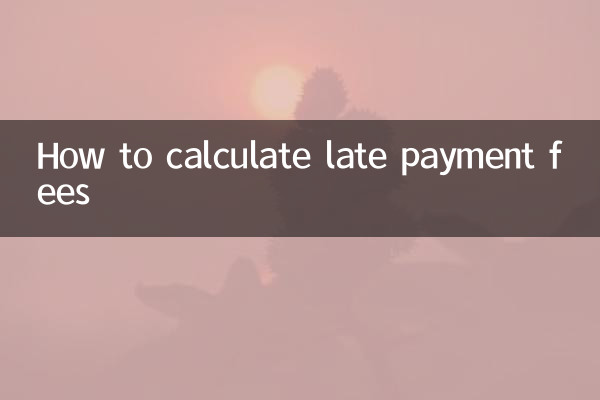How to calculate late payment fees
Late payment fees are additional penalties arising from failure to pay fees on time, and are common in scenarios such as utility bills, credit card repayments, and tax payments. With recent adjustments to late payment fee calculation rules in many places, this topic has once again become the focus of public attention. This article will combine the popular discussions on the Internet in the past 10 days, systematically analyze the calculation method of late payment fees, and provide structured data reference.
1. Calculation logic of late payment fees

Late payment fees are usually calculated based on the number of days overdue and a fixed ratio. The formula is:Late payment fee = amount payable × late payment penalty rate × number of overdue days. There are differences in calculation rules in different fields. The following are the late payment fee standards in recent hot fields:
| Project type | Late fee rate (day) | upper limit | hot events |
|---|---|---|---|
| Credit card repayment | 0.05%-0.1% | No more than the principal | A bank was notified for overcharging |
| personal income tax | 0.05% | No clear upper limit | Deadline for personal tax settlement and payment sparks heated discussion |
| Property fees | 0.3%-1% | Different places | A community property owner committee sued the property for violating regulations |
2. Late payment fee calculation example
Take a credit card debt of RMB 10,000 that is overdue for three days as an example (calculated based on a daily interest rate of 0.05%):
| Calculate elements | numerical value |
|---|---|
| Amount due | 10,000 yuan |
| Late fee rate | 0.05% |
| Days past due | 3 days |
| Total late payment fees | 10,000×0.0005×3=15 yuan |
3. Controversial hot spots on late payment fees
Recent discussions across the Internet have focused on three aspects:
1.Double billing issue: A car owner in a certain place found that the late payment penalty for traffic fines exceeded three times the principal, triggering controversy over the "late payment snowball" phenomenon.
2.Reduction policy: Since June, many places have implemented "no penalty for first violation", but there is no unified standard for whether late payment fees can be reduced or exempted.
3.Calculate transparency: Third-party payment platforms have been complained about not clearly displaying the late payment fee calculation process, and the number of related complaints has increased by 37% month-on-month.
4. Suggestions to avoid late payment fees
1.Set up automatic deductions: 90% of late payment disputes arise from forgetting to pay.
2.Understand the grace period: Some institutions have a grace period of 3-15 days (table below)
| Institution type | grace period | Remark |
|---|---|---|
| commercial bank | 3 days | Need to apply actively |
| Public Utilities | 7-15 days | Varies from place to place |
| Network platform | 0-3 days | Partial instant billing |
3.Appeal promptly: If late payment fees are incurred due to system failure, you can apply for cancellation after saving the evidence.
5. Legal provisions
According to Article 45 of the Administrative Enforcement Law, late payment fines shall not exceed the amount of the monetary payment obligation. A recent case from the Supreme People's Court made it clear that in the case of continuous overdue payments, late payment fees should be calculated based on the original debt, and interest cannot be superimposed.
It is recommended that when encountering high late payment fees, you can protect your rights through the 12315 platform or the local court. Data shows that the winning rate of late fee dispute lawsuits in 2023 will reach 68%. The key point is to prove that the charging party has not fulfilled its obligation to make clear notifications.

check the details

check the details